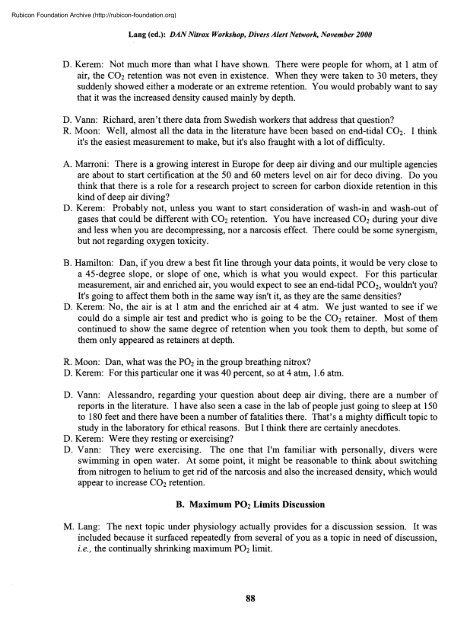Nitrox workshop dings - Divers Alert Network
Nitrox workshop dings - Divers Alert Network
Nitrox workshop dings - Divers Alert Network
You also want an ePaper? Increase the reach of your titles
YUMPU automatically turns print PDFs into web optimized ePapers that Google loves.
Rubicon Foundation Archive (http://rubicon-foundation.org)Lang (ed.): DAN <strong>Nitrox</strong> Workshop, <strong>Divers</strong> <strong>Alert</strong> <strong>Network</strong>, November 2000D. Kerem: Not much more than what I have shown. There were people for whom, at 1 atm ofair, the CO2 retention was not even in existence. When they were taken to 30 meters, theysuddenly showed either a moderate or an extreme retention. You would probably want to saythat it was the increased density caused mainly by depth.D. Vann: Richard, aren't there data from Swedish workers that address that question?R. Moon: Well, almost all the data in the literature have been based on end-tidal CO2. I thinkit's the easiest measurement to make, but it's also fraught with a lot of difficulty.A. Marroni: There is a growing interest in Europe for deep air diving and our multiple agenciesare about to start certification at the 50 and 60 meters level on air for deco diving. Do youthink that there is a role for a research project to screen for carbon dioxide retention in thiskind of deep air diving?D. Kerem: Probably not, unless you want to start consideration of wash-in and wash-out ofgases that could be different with CO2 retention. You have increased CO2 during your diveand less when you are decompressing, nor a narcosis effect. There could be some synergism,but not regarding oxygen toxicity.B. Hamilton: Dan, if you drew a best fit line through your data points, it would be very close toa 45-degree slope, or slope of one, which is what you would expect. For this particularmeasurement, air and enriched air, you would expect to see an end-tidal PCO2, wouldn't you?It's going to affect them both in the same way isn't it, as they are the same densities?D. Kerem: No, the air is at 1 atm and the enriched air at 4 atm. We just wanted to see if wecould do a simple air test and predict who is going to be the CO2 retainer. Most of themcontinued to show the same degree of retention when you took them to depth, but some ofthem only appeared as retainers at depth.R. Moon: Dan, what was the PO2 in the group breathing nitrox?D. Kerem: For this particular one it was 40 percent, so at 4 atm, 1.6 atm.D. Vann: Alessandro, regarding your question about deep air diving, there are a number ofreports in the literature. I have also seen a case in the lab of people just going to sleep at 150to 180 feet and there have been a number of fatalities there. That's a mighty difficult topic tostudy in the laboratory for ethical reasons. But I think there are certainly anecdotes.D. Kerem: Were they resting or exercising?D. Vann: They were exercising. The one that I'm familiar with personally, divers wereswimming in open water. At some point, it might be reasonable to think about switchingfrom nitrogen to helium to get rid of the narcosis and also the increased density, which wouldappear to increase CO2 retention.B. Maximum PO2 Limits DiscussionM. Lang: The next topic under physiology actually provides for a discussion session. It wasincluded because it surfaced repeatedly from several of you as a topic in need of discussion,i.e., the continually shrinking maximum PO2 limit.88
















